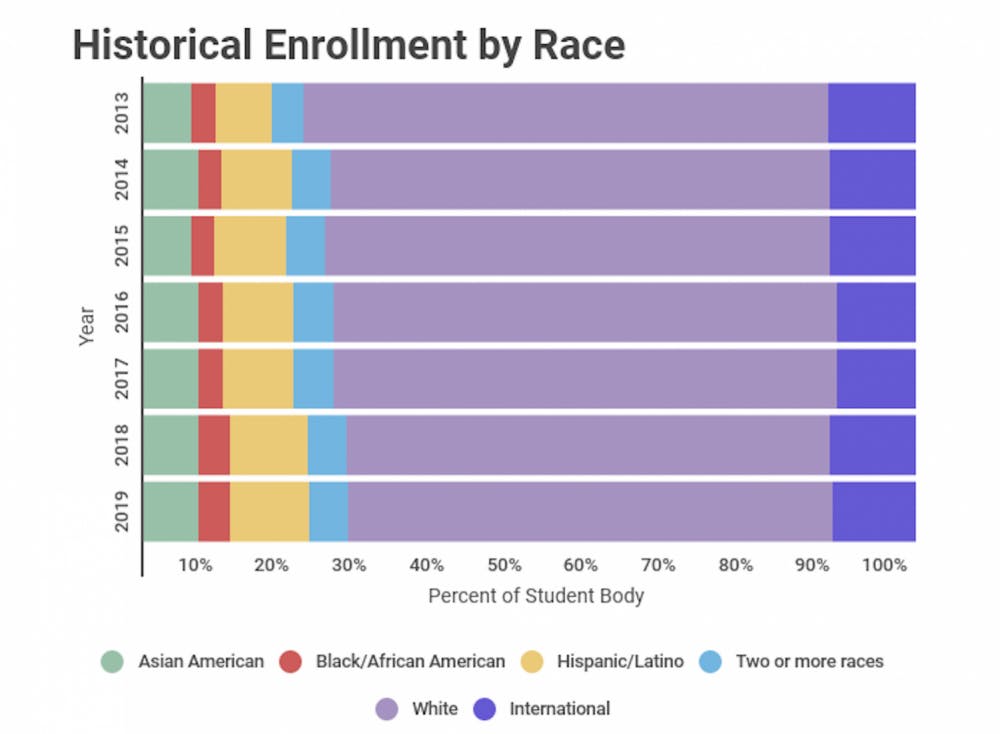Middlebury’s student body has more people of color and more students from Southern states this year than ever before. The 2019 Fall Student Body Profile points to small but distinct trends toward greater racial, ethnic and geographic diversity among students, making this the least-white student body in Middlebury history. At the same time, however, the college’s population is still primarily drawn from the same states it historically has been.
This year, Middlebury’s domestic student population is comprised of 26% students of color, the highest in the school’s history. The report also reports that the student body is currently 53.1% female and 46.9% male.
[infogram id="_/6G2Dt5oVcQ2HxquzsacD" prefix="UuY" format="interactive" title="Admissions – Race/Gender"]
Dean of Admissions Nicole Curvin is happy about how the admissions team has “made progress in bringing students from many backgrounds, geographies and lived experiences” to the college.
“The admissions team has worked intentionally to broaden our reach to more diverse student populations in the U.S. and I believe we have made good strides,” Curvin said.
Curvin cited over 50 community organizations in the country that the college works with — these groups provide support, such as application prep, internships and admissions counseling for college applicants from groups that are traditionally underrepresented in higher education, with the hopes of building bridges between students from these groups and the college.
Massachusetts is now the most represented state in the student body, taking the lead over New York, which held the top spot in 2018. California and Connecticut hold the next two spots, as they did last year.
However, the profile also points to increases in the populations of students in many traditionally underrepresented Southeastern states. North Carolina has seen a 37% increase among the student population, while Georgia has seen a 21% increase. Texas is now the 10th most represented state, while Virginia and Florida take the 11th and 12th spots respectively.
Natalie Figueroa, the admissions counselor for several Southeastern states including Alabama, Georgia, Kentucky, Louisiana, Mississippi, North and South Carolina and Tennessee, pointed to an evolution in the way that admissions counselors reach out to students in these states. This can include group travel with other liberal arts colleges such as Bates, Harvey Mudd, Wellesley and Wesleyan to high school visits, college fairs and counselor breakfasts.
[infogram id="_/t3Zvz7XqqBrudPzKliBe" prefix="gZi" format="interactive" title="Copy 2: Admissions Trends"]
“What has been especially important for me is to listen to the needs of students and high school counselors in those areas and to understand what best helps them through this process,” Figueroa said. “This can include elaborating on what a ‘liberal arts education’ entails, what winter is like, or how the transition has been for students coming to the Northeast for school.”
Visits from an admissions counselor can make the difference in a decision for some students from the South.
In addition to learning about the college from upperclassmen and being attracted to the language programs, Sophie Mueller ’23, a student from a private school in Atlanta, Georgia, met with a Middlebury counselor at a college fair during all four years of high school.
“These interactions encouraged me to apply and helped me learn more about Midd,” she said.
Curvin estimates that the high schools the admissions office visits are 60% private schools and 40% public.
Other students from the South have found their way to Middlebury through personal research, postings on sites like College Point, and through friends and peers who had gone to the Northeast for college themselves.
Ryan Kirby ’22 is from Lorena, Texas and applied to Middlebury at the recommendation of a friend up north. “I had never heard about Middlebury. New England was never even a thought to anybody at my school, and I am fairly certain I’m the only person in my class that came up north. Most did not leave the state.”
Kirby’s experience is not rare: Curvin pointed to lack of name recognition, as well as weather and financial challenges, as major factors that discourage students in the South from considering or attending Middlebury.
In a Newsroom article from last March, Curvin discussed a several-year effort to expand recruitment in Florida and other Southern states. Florida had the fifth highest rate of admitted students for the class of 2023, with 63 admitted, but ultimately had a lower yield than Northeastern states. Florida remains outside of the top-ten-most represented states on campus.
“There are a lot of conversations about affordability — coming to an institution like Middlebury over a state institution with merit money or funding for students is challenging, and those are conversations that we’re having,” Curvin said. “Florida is a beautiful lovely place with beaches and warm weather, and so talking to students about coming to New England can be a challenge, but I think we’ve seen a growth in students wanting to have this kind of college experience.”
“It was difficult to look at the price of Middlebury versus the University of Florida and Florida State and reason it,” said Kate Talano ’21.5 of Naples, Florida. “New England is a different way of life and if you’re not familiar with it, that can prevent you from wanting to go up north.”
“When you’re looking schools, you know the places that you know,” Talano said. “And in Florida, Middlebury is not one of those places.”

Riley Board '22 is the Editor in Chief of The Campus. She previously served as a Managing Editor, News Editor, Arts & Academics Editor and writer.
She is majoring in Linguistics as an Independent Scholar and is an English minor on the Creative Writing Track.
Board has worked as a writer at Smithsonian Folklife Magazine and as a reporter for The Burlington Free Press. Currently, she is a 2021-2022 Kellogg Fellow working on her linguistics thesis. In her free time, you can find her roller skating in E-Lot or watching the same sitcoms over and over again.




